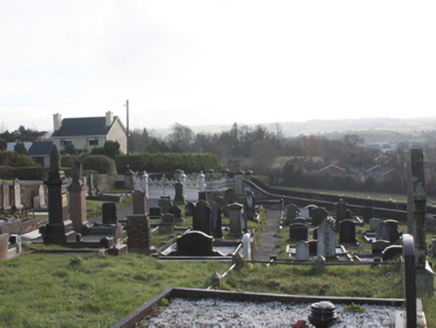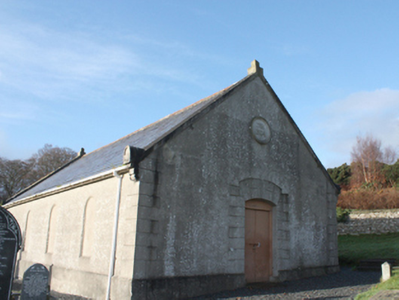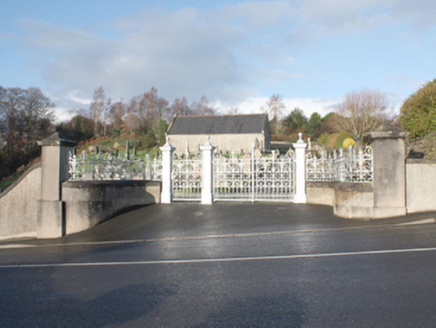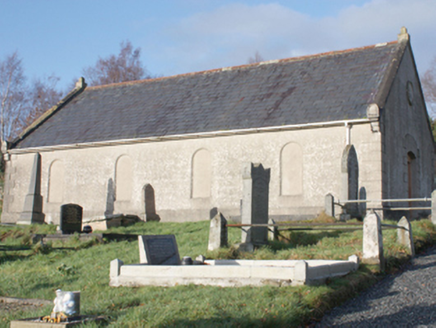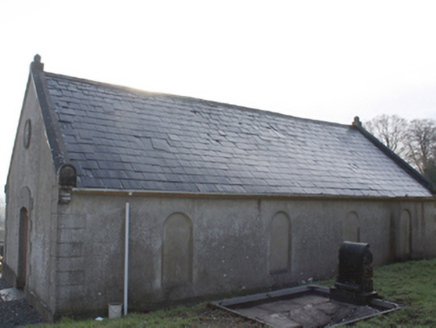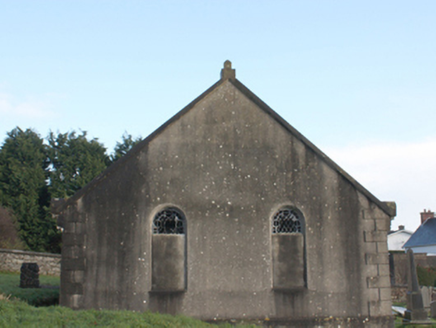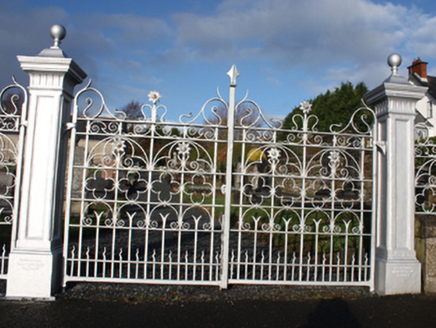Survey Data
Reg No
40905305
Rating
Regional
Categories of Special Interest
Archaeological, Architectural, Social
Original Use
Church/chapel
Historical Use
Church/chapel
Date
1900 - 1910
Coordinates
217988, 412104
Date Recorded
28/11/2008
Date Updated
--/--/--
Description
Freestanding gable-fronted former Reformed Presbyterian church, remodelled and dated 1904 and possibly containing fabric of earlier church\meeting house to site, built 1785, comprising a four-bay hall. Later in use as a Presbyterian meeting house\church (from c. 1925). Now out of use. Pitched natural slate roof with terracotta ridge tiles, projecting eaves course, raised rendered verges to the gable ends (south-west and north-east) having moulded rendered kneeler stones to eaves having round-headed finials over, stepped rendered finials to gable apexes, and with cast-iron rainwater goods. Smooth rendered ruled-and-lined walls over smooth rendered plinth course and with raised rendered block-and-start quoins to the corners. Round date plaque with architraved surround to the north-east gable end, over doorway, having recessed rendered lettering reading ‘1784’ and ‘1905. Round-headed window openings to the south-east, north-west and south-east elevations, now blocked\boarded, having remains of leaded coloured glass windows; window openings to the north-west possibly blind. Segmental-headed doorway to the centre of the north-east elevation having raised render block-and-start surround and replacement metal-clad double-doors. Set back from road in elevated site to the north-east of the centre of Letterkenny. Graveyard to site having collection of mainly nineteenth and twentieth century upstanding and recumbent gravestones, some with metal railed enclosures. Graveyard still in use. Rubble stone boundary walls to site, those to the road-frontage to the south having rendered front wall, coping and panels. Main vehicular gateway to the south-east corner of site comprising a pair of decorative cast-iron gate posts with ball finials over, and a pair of decorative wrought-iron gates. Gateway flanked to the west by pedestrian gateway having decorative cast-iron gate post with ball finial over and decorative wrought-iron gate. Gateway flanked to either side by curved sections of rendered walling with decorative wrought-iron railings over, and with rendered gate piers (on square-plan) having moulded rendered coping over.
Appraisal
This simple hall-type former Reformed Presbyterian church\meeting house, later in use as a Presbyterian church\meeting house, retains it original character and form despite being now out of use. Its visual expression and integrity is enhanced by the retention of salient fabric including natural slate roof, and leaded windows (now blocked). Subdued decorative interest is added by the simple block-and-start quoins to the corners, the surrounds to the doorway, and by the raised rendered verges to the gable ends with kneeler stones and finials. The simple date plaque to the entrance gable (north-east) records the dates ‘1785’, the original establishment of this church\congregation, and ‘1904’ when it was altered\rebuilt and when the fine gates to the south-east corner of the site were erected. This building was originally or formerly in use as a Reformed Presbyterian church and\or Covenanters’ church from at least the early nineteenth century (depicted as a ‘Covenanter’s Meeting House’ on Ordnance Survey first edition six-inch map of 1837) though it may originally date to 1785 as the plaque suggests. The plain main elevations and the relatively lack of detailing is indicative of the restrained doctrine of the Reformed Presbyterian Church - buildings are typically simple halls in design, with a central pulpit, under which is a communion table. The origins of the Reformed Presbyterian church in Ireland are associated with the arrival of Scottish settlers in Ulster during the Plantations of the early seventeenth century, most of which were Presbyterian in religious belief. The Reformed Presbyterian Church was created by Presbyterians who objected to the disregarding of the Covenants (hence the name Covenanters), which was brought about by the Revolution Settlement of 1690, and they began to hold separate meetings to the Presbyterians. Initially they were dependent on visits from Scottish ministers from 1696 until 1757. In 1763 a 'Reformed Presbytery' was formed and rapid growth led to the formation of a Synod in 1811. This congregation in Letterkenny (present place of worship in modern building in the town) is one of four within the Reformed Presbyterian Church in Donegal, the others being at nearby Stranorlar and Convoy, with another congregation based in Millford. This Presbyterian congregation was one of three or four operating in Letterkenny during the nineteenth and twentieth centuries (three of which were formerly known as the First, Second, and Third Presbyterian Churches) along with other buildings on Cathedral Square (see 40501166, now in use as a hall) and Trinity Church (see 40502092) on Main Street, built 1905-7 replacing an earlier Letterkenny First Presbyterian church in Letterkenny. The Presbyterian congregations in Letterkenny merged in 1925 under the Revd. Dodds. A Revd. William Gamble was apparently one of the first ministers of the Reformed Presbyterian Church in Letterkenny, and was installed in July 1788. A Revd. William Henry was minister here in 1846, and a Revd. Joseph Moffett in 1881 and 1894 (all Slater’s Directory). This modest building is an integral element of the built heritage and social history of the Letterkenny, and is an interesting reminder of the religious diversity in this part of Donegal at the time of construction. The graveyard to site contains a collection of mainly nineteenth and twentieth century gravemarkers of both recumbent and upstanding types, some with railed enclosures, and some of which are of modest artistic merit, adding to the context. The fine gateway to the south-east corner of site with elaborate cast-iron gate posts and intricate wrought-iron gates and railings adds significantly to the setting, and is an interesting feature along the roadscape to the north-east of Letterkenny in its own right. These were apparently erected in 1904 by Michael O’Callaghan, Town surveyor, of Letterkenny, and an assistant county surveyor for Co. Donegal, after tenders were sought in 1902 for ‘new boundary walls and gates to graveyard & grounds, and for repairs to meeting house’. The foundry mark to the gate piers indicates that they were made by Ravenhill Ironworks Ltd., Belfast.
